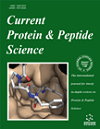- Home
- A-Z Publications
- Current Protein and Peptide Science
- Previous Issues
- Volume 16, Issue 3, 2015
Current Protein and Peptide Science - Volume 16, Issue 3, 2015
Volume 16, Issue 3, 2015
-
-
Adiponectin in Asthma: Implications for Phenotyping
More LessAsthma is a heterogeneous inflammatory airway disease, which exhibits multiple phenotypes, mainly defined by a combination of different clinical features. Asthma phenotypes include age at onset, smoking status, exacerbations frequency, and co-existence of obesity. Links between specific biological pathways and phenotypes are emerging. The genetic background together with detectable biomarkers could more accurately Read More
-
-
-
Abiotic Regulation: A Common Way for Proteins to Modulate their Functions
More LessAuthors: Zhi Zou and Xinmiao FuModulation of protein intrinsic activity in cells is generally carried out via a combination of four common ways, i.e., allosteric regulation, covalent modification, proteolytic cleavage and association of other regulatory proteins. Accumulated evidence indicate that changes of certain abiotic factors (e.g., temperature, pH, light and mechanical force) within or outside the cells directly influence protein structure and thus profou Read More
-
-
-
The Bioactive Acidic Serine- and Aspartate-Rich Motif Peptide
More LessAuthors: Tomoko Minamizaki and Yuji YoshikoThe organic component of the bone matrix comprises 40% dry weight of bone. The organic component is mostly composed of type I collagen and small amounts of non-collagenous proteins (NCPs) (10-15% of the total bone protein content). The small integrin-binding ligand N-linked glycoprotein (SIBLING) family, a NCP, is considered to play a key role in bone mineralization. SIBLING family of proteins share common s Read More
-
-
-
Crypteins - An Overlooked Piece of Peptide Systems
More LessAuthors: Joanna Ner, Jolanta H. Kotlinska and Jerzy SilberringCrypteins, the hidden bioactive sequences, play an important role in the modulation of various biological processes, such as neuronal signaling, angiogenesis, immune response, inflammatory response and cell growth. Proteolytic mechanism leading to the release of crypteins possessing novel biological activities is an important factor for increasing diversity of functional molecules and represents a potential new source of Read More
-
-
-
An Overview of Protein Identification Studies in Cassava
More LessCassava (Manihot esculenta Crantz) belongs to the Euphorbiaceae family and is originated from the Southern Amazon basin. The storage root is the most important product of cassava as food for more than 800 million people in Africa, Asia and Latin America. In this review, we present a retrospective of studies aiming the identification of cassava proteins, starting from the first investigations using SDS-PAGE and classical t Read More
-
-
-
Disorder in Milk Proteins: Caseins, Intrinsically Disordered Colloids
More LessAuthors: Elrashdy M. Redwan, Bin Xue, Hussein A. Almehdar and Vladimir N. UverskyThis article opens a series of reviews on the abundance and roles of intrinsic disorder in milk proteins. The focus of this introductory article on caseins is symbolic, since caseins were among the first recognized functional unfolded proteins and since they are definitely the most disordered, the most abundant, and the most studied of all milk proteins. In eutherian milks, the casein family includes at least three and usually fou Read More
-
-
-
Oxidative Stress and Antioxidative Enzyme Activities in Chronic Kidney Disease and Different Types of Renal Replacement Therapy
More LessThe incidence and diagnosis of chronic kidney disease (CKD) is on the rise all over the world. CKD is related to ageing of the society and high morb idity due to lif estyle diseases like diabetes, atherosclerosis, and hypertension. CKD is associated with increased oxidative stress generated by uremic toxicity, chronic inflammatory state, lack of vitamins and microelements, parenteral iron administration, and dialysis procedure i Read More
-
-
-
Angiogenesis-Related Proteins - Their Role in the Pathogenesis and Treatment of Inflammatory Bowel Disease
More LessAuthors: Piotr Eder, Katarzyna Korybalska, Krzysztof Linke and Janusz WitowskiThe etiology of inflammatory bowel disease (IBD) is still not fully understood. Angiogenesis is one of the crucial phenomena sustaining chronic inflammation in the gastrointestinal tract. It has been also shown that the most potent anti-inflammatory drugs - anti-tumor necrosis factor alpha antibodies down-regulate intestinal angiogenesis, what is believed to contribute to their therapeutic efficacy. There are many proteins e Read More
-
-
-
Structure and Function of Water Molecules Buried in the Protein Core
More LessAlthough the formation of the apolar core is crucial for protein folding, protein interior is often packed sub-optimally and incorporates water molecules that leave the bulk solvent. On average, one buried water molecules is observed every 20-90 amino acids, depending on the protein dimension and structural class: more buried water molecules are observed in large proteins and less in alpha proteins. From a structural Read More
-
Volumes & issues
-
Volume 26 (2025)
-
Volume 25 (2024)
-
Volume 24 (2023)
-
Volume 23 (2022)
-
Volume 22 (2021)
-
Volume 21 (2020)
-
Volume 20 (2019)
-
Volume 19 (2018)
-
Volume 18 (2017)
-
Volume 17 (2016)
-
Volume 16 (2015)
-
Volume 15 (2014)
-
Volume 14 (2013)
-
Volume 13 (2012)
-
Volume 12 (2011)
-
Volume 11 (2010)
-
Volume 10 (2009)
-
Volume 9 (2008)
-
Volume 8 (2007)
-
Volume 7 (2006)
-
Volume 6 (2005)
-
Volume 5 (2004)
-
Volume 4 (2003)
-
Volume 3 (2002)
-
Volume 2 (2001)
-
Volume 1 (2000)
Most Read This Month
Article
content/journals/cpps
Journal
10
5
false
en


